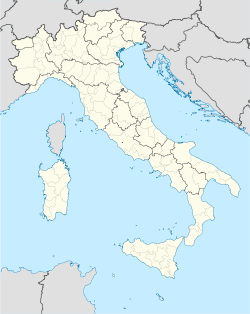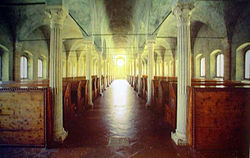- Cesena
-
For Cesena football club, see A.C. Cesena.
Cesena — Comune — Comune di Cesena Panorama of Cesena 
Coat of armsLocation of Cesena in Italy Coordinates: 44°08′N 12°14′E / 44.133°N 12.233°ECoordinates: 44°08′N 12°14′E / 44.133°N 12.233°E Country Italy Region Emilia-Romagna Province Forlì-Cesena (FC) Frazioni see list Government - Mayor Paolo Lucchi (Partito Democratico) Area - Total 249.47 km2 (96.3 sq mi) Elevation 44 m (144 ft) Population (12-21-2009) - Total 95,909 - Density 384.5/km2 (995.7/sq mi) Demonym Cesenati Time zone CET (UTC+1) - Summer (DST) CEST (UTC+2) Postal code 47521 - 47522 Dialing code 0547 Patron saint St. John the Baptist Saint day June 24 Website Official website Cesena (Italian pronunciation: [tʃɛˈzeːna]) is a city and comune in the Emilia-Romagna region of northern Italy, south of Ravenna and west of Rimini, on the Savio River, co-chief of the Province of Forlì-Cesena. It is at the foot of the Apennines, and about 15 km from the Adriatic Sea.
Contents
History
Cesena was originally an Umbrian or Etruscan town, known as Caesena. After a brief spell under Gaulish rule, it was taken over by Romans in the 3rd century BC. It was a garrison town of strategic importance which was destroyed in the wars between Gaius Marius and Sulla. Pliny mentions the wines of Cesena as among the best.
Cesena was on the border that the Exarchate of Ravenna shared with the Lombards. It was presented to the Papacy by its Frankish conqueror in 754 and passed back and forth between the popes and the archbishops of Ravenna, was briefly a communal republic (1183–1198). It was then long contested between popes and Holy Roman Emperors. The brief rule by the Forlivese Ordelaffi was crushed in 1357 by Papal troops led by Cardinal Gil de Albornoz, after a long siege heroically endured by Cia degli Ordelaffi, wife of the Lord of Forlì.
The little comune revolted again in 1377 during the War of the Eight Saints. This time it was recaptured by Breton troops of Giovanni Acuto (the English-born condottiere John Hawkwood) under the command of Robert, Cardinal of Geneva, (later antipope Clement VII). The latter, acting as the legate of Pope Gregory XI, directed the savage murder of between 2,500 and 5,000 civilians. By the laws of war at the time this was regarded as an atrocity that earned the label of the "Cesena Bloodbath" and the cardinal the "butcher of Cesena". The following year what remained of Cesena was assigned by the new pope Urban VI to Galeotto I Malatesta.
During the period 1379-1465 the city recovered and prospered under the Malatesta, who rebuilt the castle (called Rocca Malatestiana) overlooking the town. The Malatestiana Library, built by near the castle by Malatesta Novello (1429), is considered a fine example of a Renaissance library and holds many valuable manuscripts.
After Novello's death (1465), Cesena returned to the Papal States, but was again seized by a local seignor, Cesare Borgia, in 1500. The city was elevated to capital of his powerful though short-lived duchy.
Cesena subsequently turned into a secondary city of the Papal States. In the 18th and 19th centuries Pope Pius VI and Pope Pius VII were born in the city, which also had Pope Pius VIII as bishop, gaining the title of "city of the three popes". During the Napoleonic Wars it was stripped of numerous monasteries and churches. Some of its citizens had notable roles in the unification of Italy, in the second half of the 19th century.
During World War II Cesena was near the Gothic Line, which ran along the Appennini near the city, and suffered heavily from bombing.
In 1992 it was elevated to the rank of co-capital of province, together with Forlì.
Main sights
Cesena's monuments include:
- the Abbey of St Maria del Monte.
- the Malatestian Fortress (Rocca Malatestiana), built by Cardinal Albornoz (from 1380) over a pre-existing edifice which had hosted, among the others, Frederick Barbarossa and his nephew Frederick II. It was completed by the Papal governor Lorenzo Zane in 1480, and was used by Cesare Borgia as jail for Caterina Sforza. It is octagonal, with two main towers, the higher maschio and the lower foemina
- the Piazza del Popolo
- the Biblioteca Malatestiana, the first public library in Europe.
- the Cathedral of Saint John the Baptist.
- The Pinacoteca Comunale is housed in what was once a Benedictine monastery.
- The Galleria dei dipinti antichi della Cassa di Risparmio di Cesena is housed in what was once a Celestine monastery.
- The Teatro Alessandro Bonci.
Economy
Cesena's industry centers on agriculture, handicrafts, and tourism.
Transport
Cesena railway station, opened in 1861, forms part of the Bologna–Ancona railway. It is situated at Piazza Giorgio Sanguinetti, to the northeast of the city centre.
Bounding communes
- Mercato Saraceno
- Cesenatico
- Cervia
- Ravenna
- Gambettola
- Montiano
- Longiano
- Roncofreddo
- Meldola
- Bertinoro
- Sarsina
Notable people
- Nicoletta Braschi, Italian actress, best known for her work with her husband, actor and director Roberto Benigni
- Alberto Sughi, Italian painter
- Pope Pius VI, was Pope from February 15, 1775 to August 29, 1799
- Pope Pius VII, was Pope from March 14, 1800 to August 20, 1823.
- Obadiah ben Jacob Sforno
- Alessandro Bonci, operatic tenor
Marco Pantani
Frazioni
Acquarola, Aie, Bagnile, Borello, Borgo di Ronta, Borgo delle Rose, Borgo Paglia, Botteghino, Budrio, Bulgaria, Bulgarnò, Calisese, Calabrina, Capannaguzzo, Carpineta, Casalbono, Casale, Case Castagnoli, Case Frini, Case Gentili, Case Missiroli, Case Scuola Vecchia, Celincordia, Celletta, Diegaro, Formignano, Gattolino, Gualdo, Il Trebbo, Lizzano, Luogoraro, Luzzena, Macerone, Madonna dell'Olivo, Martorano, Massa, Molino Cento, Monte Aguzzo, Monte Vecchio, Montereale, Monticino, Oriola, Osteria di Piavola, Paderno, Pievesestina, Pioppa, Ponte Abbadesse, Ponte Pietra, Pontecucco, Provezza, Rio Eremo, Rio Marano, Ronta, Roversano, Ruffio, Saiano, San Carlo, San Cristoforo, San Demetrio, San Giorgio, San Mamante, San Martino in Fiume, San Matteo, San Tomaso, San Vittore, Santa Lucia, Sant'Andrea in Bagnolo, Settecrociari, Tessello, Tipano, Torre del Moro, Trebbo, Valdinoce, Villa Calabra, Villa Casone. Marco Pantani
See also
External links
- Cesena home page (Italian)
- Cesena history and info (English)
- Cesena info (English)
- Detailed timeline of Cesena's rulers
Emilia-Romagna · Comuni of the Province of Forlì-Cesena Bagno di Romagna · Bertinoro · Borghi · Castrocaro Terme e Terra del Sole · Cesena · Cesenatico · Civitella di Romagna · Dovadola · Forlimpopoli · Forlì · Galeata · Gambettola · Gatteo · Longiano · Meldola · Mercato Saraceno · Modigliana · Montiano · Portico e San Benedetto · Predappio · Premilcuore · Rocca San Casciano · Roncofreddo · San Mauro Pascoli · Santa Sofia · Sarsina · Savignano sul Rubicone · Sogliano al Rubicone · Tredozio · VergheretoCategories:- Cities and towns in Emilia-Romagna
- Communes of the Province of Forlì-Cesena
- Cesena
- Gothic sites in Emilia-Romagna
Wikimedia Foundation. 2010.





